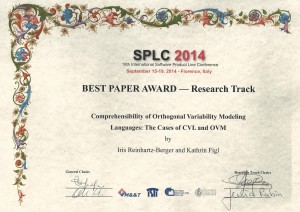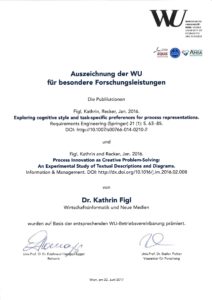Habilitation
Habilitation Guidelines
- Journal List of the Department (version from June 16, 2015; journals of the habilitation marked in yellow) (xlsx)
- Habilitation Guidelines of the Department (version from 06/2015) (pdf)
Habilitation Thesis
Including Publication Awards for 4 Top-Journal Publications
from the Vienna University of Economics and Business
Sole-Authored Journal Article (and corresponding extended abstract; listed in the department’s journal list)
- Figl, Kathrin (2017). Comprehension of Procedural Visual Business Process Models – A Literature Review. Business & Information Systems Engineering (BISE) (59) 1. Special Issue on Human Information Behaviour in IS Development and Use [open access], pp 41–67 (pdf) (Appendix) (Springer) [Listed, VHB-JQ3: B, ABDC: A, IF:2.06, WI: A]
- Extended Abtract/Presentation at a Conference: Figl, Kathrin (2017). Why are Process Models Hard to Understand? (Invited Keynote) Lecture Notes in Business Information Processing. 5th International Workshop on Cognitive Aspects of Information Systems Engineering – COGNISE’17 in conjunction with CAiSE’17. Essen, Germany. (accepted) [VHB-JQ3: C, WI: B]
Journal Articles (and corresponding extended abstracts; the journals are listed in the department’s journal list)
- Reinhartz-Berger, I., Figl, Kathrin, Haugen, Ø. (2017). Investigating Styles in Variability Modeling: Hierarchical vs. Constrained Styles. Information and Software Technology (87), pp.81-102 (pdf) (Elsevier) [Listed, ABDC: A, IF:1.57]
- Figl, Kathrin, Recker, J. (2016). Exploring Cognitive Style and Task-specific Preferences for Process Representations. Requirements Engineering 21 (1), pp.63-85. (pdf) (Springer) [Listed, IF:1.15]
- Figl, Kathrin, Recker, J. (2016). Process Innovation as Creative Problem-Solving: An Experimental Study of Textual Descriptions and Diagrams. Information & Management (53) 6, pp.767-786. (pdf) (Elsevier) [Listed, VHB-JQ3: B, WI: A, ABDC: A*, IF:2.16]
- Extended Abtract/Presentation at a Conference: Figl, K., & Recker, J. (2016). Process innovation as creative problem-solving: An experimental study of textual descriptions and diagrams. International Workshop on Enterprise Modeling and Information Systems Architectures (EMISA), Vienna, Austria. (pdf)
- Figl, Kathrin, Laue, R. (2015). Influence Factors for Local Comprehensibility of Process Models. International Journal of Human-Computer Studies (Elsevier). 82, pp.96-110. (pdf) (Elsevier) [Listed, WI: B, ABDC: B, IF:1.48]
- Extended Abtract/Presentation at a Conference: Figl, Kathrin, Laue, R. (2016). Kognitive Belastung als lokales Komplexitätsmaß in Geschäftsprozessmodellen. Konferenz Software Engineering. Lecture Notes in Informatics (LNI), Vienna, Austria. (pdf) [Listed, VHB-JQ3: C, WI: B]
- Figl, Kathrin, Mendling, J., Strembeck, M. (2013). The Influence of Notational Deficiencies on Process Model Comprehension. Journal of the Association for Information Systems (14) 6, Article 1. (pdf) (JAIS) [Listed, VHB-JQ3: A, WI: A, ABDC: A*, IF:1.79]
- Figl, Kathrin, Recker, J., Mendling, J. (2013). A Study on the Effects of Routing Symbol Design on Process Model Comprehension. Decision Support Systems (54) 2, pp.1104-1118. (pdf) (DSS) [Listed, VHB-JQ3: B, WI: A, ABDC: A*, IF:2.60]
Additional Journal Article
- Figl, Kathrin, Derntl, M., Rodriguez, M.C., Botturi, L. (2010). Cognitive Effectiveness of Visual Instructional Design Languages. Journal of Visual Languages and Computing, 21 (6), 359–373. (pdf) [IF:0.66]
Papers in Peer-Reviewed Conference Proceedings (the papers appeared in conferences with an acceptance rate < 30% or at the ECIS)
- Figl, Kathrin (2017). User Evaluation of Symbols for Core Business Process Modeling Concepts. 25th European Conference of Information Systems (ECIS). Guimarães, Portugal. (accepted) [VHB-JQ3: B, WI: A]
- Reinhartz-Berger, I., Figl, Kathrin (2014). Comprehensibility of Orthogonal
 Variability Modeling Languages: The Cases of CVL and OVM. Proceedings of 18th Software Product Line Conference, Florence, Italy: ACM. (pdf) (Best Paper Award, 28% acceptance rate)
Variability Modeling Languages: The Cases of CVL and OVM. Proceedings of 18th Software Product Line Conference, Florence, Italy: ACM. (pdf) (Best Paper Award, 28% acceptance rate) 
- Reinhartz-Berger, I., Figl, Kathrin, Haugen, Ø. (2014). Comprehending Feature Models Expressed in CVL. Proceedings of ACM/IEEE 17th International Conference on Model Driven Engineering Languages and Systems (MODELS), Valencia, Spain: Springer. (pdf) (24% acceptance rate)
- Figl, Kathrin, Koschmider, A., Kriglstein, S. (2013). Visualising Process Model Hierarchies. European Conference of Information Systems (ECIS), Utrecht, The Netherlands. (pdf) (32% acceptance rate) [VHB-JQ3: B, WI: A]
- Figl, Kathrin, Weber, B. (2012). Individual Creativity in Designing Business Processes. Advanced Information Systems Engineering Workshops. Lecture Notes in Business Information Processing. Volume 112, p. 294-306. Berlin: Springer. (pdf) (30% acceptance rate) [VHB-JQ3: C]
- Figl, Kathrin, Derntl, M. (2011). The Impact of Perceived Cognitive Effectiveness on Perceived Usefulness of Visual Conceptual Modeling Languages. 30th International Conference on Conceptual Modeling (ER 2011). Lecture Notes in Computer Science, Volume 6998/2011, Brussels, Belgium, p.78-91. (pdf) (16% acceptance rate) [VHB-JQ3: B, WI: B]
- Figl, Kathrin, Laue, R. (2011). Cognitive Complexity in Business Process Modeling. 23rd International Conference on Advanced Information Systems Engineering (CAISE). Lecture Notes in Computer Science, Volume 6741/2011, p. 452-466. (pdf) (13% acceptance rate) [VHB-JQ3: C, WI: B]
- Figl, Kathrin, Mendling, J., Strembeck, M. & Recker, J. (2010). On the Cognitive Effectiveness of Routing Symbols in Process Modeling Languages. Business Information Systems (BIS) 2010. Lecture Notes in Business Information Processing Vol.47. Berlin: Springer. (pdf) (<30% acceptance rate) [VHB-JQ3: C, WI: B]
Additional Papers in Peer-Reviewed Conference Proceedings
- Dangarska, Z., Figl, Kathrin, Mendling, J. (2016). A Cognitive Analysis of the Decision Model and Notation (DMN). Proceedings of IEEE 2nd International Workshop on Compliance, Evolution and Security in intra- and Cross-Organizational Processes, Vienna, Austria. (pdf)
- Koschmider, A., Figl, Kathrin, Schoknecht, A. (2015). Comprehensive Overview on Visual Design of Process Element Labels. Business Process Management Workshops. Lecture Notes in Business Information Processing. Innsbruck, Austria. (pdf) [VHB-JQ3: C]
- Figl, Kathrin, Strembeck, M. (2015). Findings from an Experiment on Flow Direction of Business Process Models. International Workshop on Enterprise Modelling and Information Systems Architectures (EMISA). Lecture Notes in Informatics (LNI), Innsbruck, Austria. (pdf) [VHB-JQ3: C, WI: B]
- Figl, Kathrin, Strembeck, M. (2014). On the Importance of Flow Direction in Business Process Models. Proceedings of 9th International Conference on Software Engineering and Applications. (pdf) Vienna, Austria: Scitepress.
- Figl, Kathrin (2012). Symbol Choice and Memory of Visual Models. Proceedings of IEEE Symposium on Visual Languages and Human-Centric Computing (VL-HCC), Innsbruck, Austria. IEEE Computer Society, p. 97-100. (pdf)
- Figl, Kathrin, Weber, B. (2011). Creative Personality and Business Process Redesign. 4th International Workshop on Enterprise Modelling and Information Systems Architectures (EMISA), Hamburg, Germany, Lecture Notes in Informatics 190 GI, p. 189-194. (pdf) [VHB-JQ3: C, WI: B]
- Figl, Kathrin, Mendling, J. & Strembeck, M. (2009). Towards a Usability Assessment of Process Modeling Languages. 8. GI-Workshop EPK 2009: Geschäftsprozessmanagement mit Ereignisgesteuerten Prozessketten. CEUR-WS: Berlin. (pdf)
Journal & Conference Ranking
- Listed – Journal is listed in the department list
- VHB-JQ – Ranking based on VHB-Jourqual 3 (2015): 1 x A; 6 x B; 12 x C; 2 x D
- WI – Ranking based on WKWI (“Wissenschaftliche Kommission für Wirtschaftsinformatik”) WI journal list (2008): 7 x A; 13 x B
- ABDC – ABDC 2016 Ranking (“Australian Business Deans Council”): 3 x A*, 2 x A; 2 x B
- IF – Thomson-Reuters Impact Factor



 Variability Modeling Languages: The Cases of CVL and OVM. Proceedings of 18th Software Product Line Conference, Florence, Italy: ACM. (pdf) (Best Paper Award, 28% acceptance rate)
Variability Modeling Languages: The Cases of CVL and OVM. Proceedings of 18th Software Product Line Conference, Florence, Italy: ACM. (pdf) (Best Paper Award, 28% acceptance rate) 
